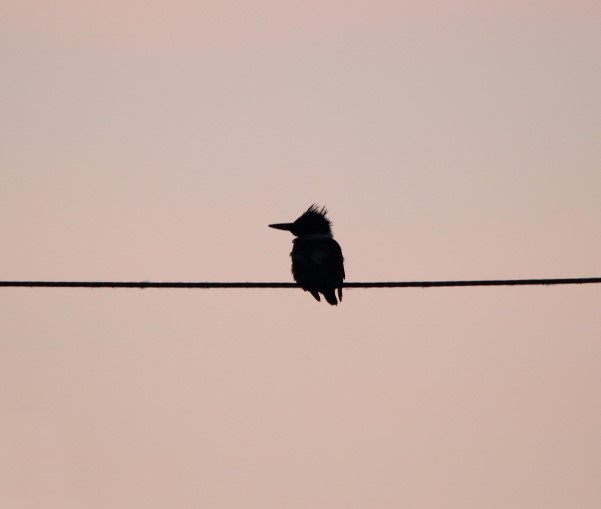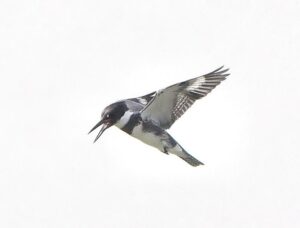Belted Kingfisher, Megaceryle alcyon
Bill Rowe
Hang around a lake, creek, river, or marsh long enough, and eventually you are sure to hear the loud harsh rattle of a Belted Kingfisher patrolling its territory. This is an all-American bird, for its breeding range covers the better part of our continent, all but the high Arctic and the southwestern U.S., and its winter range extends down through Middle America and the Caribbean to the northern coast of South America. For most of us, it is our only representative of the worldwide kingfisher family, which comprises over 100 species on six continents, wearing all sorts of bold, bright colors and patterns. The U.S. has only two additional species, with very restricted ranges north of the Mexican border: the bigger Ringed Kingfisher (south Texas) and the smaller Green Kingfisher (there and also southern Arizona). All kingfishers are characterized by a long heavy bill for capturing—what else?—fish, or sometimes crayfish. They search by flying low, hovering in place, or sitting quietly on a branch as a scanning perch, and when they spot a prey item they plunge into the water after it. Belted Kingfishers are solitary birds, usually seen one at a time or at least well spaced along the length of a creek, except of course for the nesting season, when male and female team up to excavate a 3-to-6-foot-long burrow in the soil of a stream bank.
IDENTIFICATION: Not much like any other bird, with its big head that displays a ragged crest (as if it used too much gel), its long, stout bill, and its overall blue-gray color with a white collar and belly. The male has a wide “belt” across the breast, also blue-gray, while the female adds a lower belt of rusty brown, making her one of only a few females among our birds that are more brightly patterned than the male.
ST. LOUIS STATUS: The designation “uncommon” means a bird that is reasonably widespread and seen regularly but in smaller numbers than the “common” ones, and thus more easily missed. That is the exact status of Belted Kingfishers here in our area: you can see them year-round unless there is a very hard freeze, but finding more than two or three in a day is unusual.
Learn more and listen to the calls of Belted Kingfishers here.
Male hovering
Photo Credit: Al Smith
Easy to identify!






